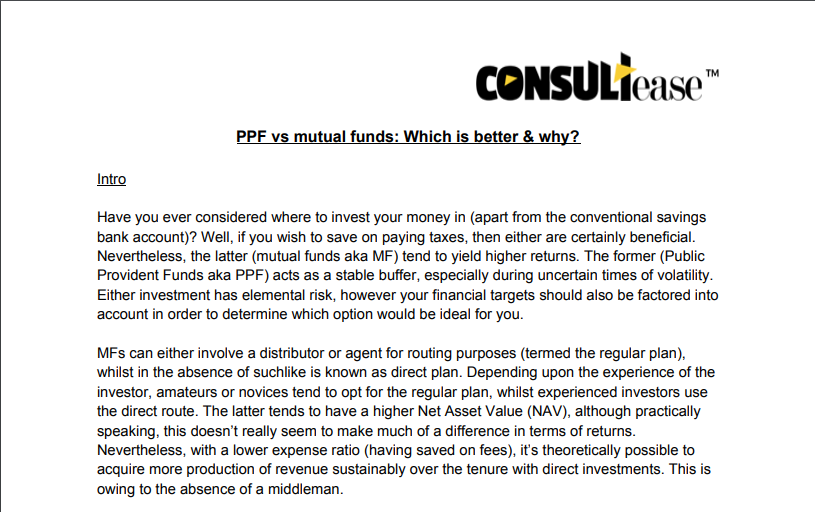PPF vs mutual funds: Which is better & why?
Table of Contents
PPF vs mutual funds: Which is better & why?
Intro
Have you ever considered where to invest your money (apart from the conventional savings bank account)? Well, if you wish to save on paying taxes, then either is certainly beneficial. Nevertheless, the latter (mutual funds aka MF) tend to yield higher returns. The former (Public Provident Funds aka PPF) acts as a stable buffer, especially during uncertain times of volatility. Either investment has elemental risk, however, your financial targets should also be factored into account in order to determine which option would be ideal for you.
MFs can either involve a distributor or agent for routing purposes (termed the regular plan), whilst in the absence of suchlike is known as a direct plan. Depending upon the experience of the investor, amateurs or novices tend to opt for the regular plan, whilst experienced investors use the direct route. The latter tends to have a higher Net Asset Value (NAV), although practically speaking, this doesn’t really seem to make much of a difference in terms of returns. Nevertheless, with a lower expense ratio (having saved on fees), it’s theoretically possible to acquire more production of revenue sustainably over the tenure with direct investments. This is owing to the absence of a middleman.
Intermediaries can also be avoided by simply directly approaching investing centers, visiting the MF company’s website, or even the Asset Management Company (AMC). This way, brokers or advisors are eliminated, as are their respective fees! Hence, a serviced economy is promoted.
Inherent risk
Mutual funds are generally categorized into equity, debt-oriented, or hybrid schemes, dependent on the risk appetite of the investor. The most popular method of investing in Mutual funds is a Systematic investment plan (SIP). With this, one can invest a fixed amount at regular intervals in the scheme.
Contrarily, PPF is a longer-term model operated & backed by the Central Government with the aim of encouraging a public savings culture. These investments are mainly in fixed income securities that generate a fixed rate of return, ensuring income stability. Hence a PPF calculator can calculate the anticipated returns based on annual investment levels. PPF is a risk-free investment, as the funds deposited are utilized by the government for its budget purposes. They then add interest. This results in a lower risk of defaults than compared to MF, stabilizing returns.
MFs are comparatively riskier than PPFs as they invest in stocks & thus prone to volatile risk. The value of equity funds fluctuates due to stock price variance in funds. Debt funds are an extension of MFs which vary in value owing to variations in bond market pricing. Nevertheless, they are safer & more stable. Be mindful that not every mutual fund is risky. There are low-risk options too. This risk is inherent, given the high return potential of mutual funds over time.
Investing by SIP mode eliminates this volatility factor by some degree via lengthening or distributing the investment tenure over a longer period of time.
Returns
MFs tend to offer better ROIs, owing to more independence, although PFFs are government-backed, meaning that technically speaking, they’re safer. However, with longer-term tenures & maturation, PFFs can pose a liquidity risk. Hence, MFs are better for income generation, whilst PFFs remain ideal for asset preservation. Don’t forget to be mindful of the investment limit of Rs. 1.5 LPA for PPF for tax saving purposes, whereas there’s no such imposition for MF.
PPF is a popular savings option run by the Government of India with the intention of accumulating savings to establish a pool while featuring a decent interest rate & tax benefits. Return on PPF is tallied on an annual basis. According to historic trends, the rates hover around 8% p.a. This is subject to variation, as per government policies. The rate is determined every quarter. The returns on PPF are fixed and guaranteed by the government. There is therefore no risk of losing one’s capital investment.
The return generated from each MF scheme is asset performance-dependent & often connected to markets. Therefore, market performance, as well as the fund management strategies & allocation in each asset class, affects MF returns. The return from mutual funds can be skyrocketing. But the risk level is also high. There are chances of losses also. In some of the mutual funds, investors may have the risk of wiping off their investment too. But PPF is stable. They don’t offer any unexpected returns, but then ensures the safety of investment with small returns on it.
Taxation
The tax treatment of mutual funds depends upon the kind of scheme & period of investment. PPF is tax-free up to a limit of Rs 1.5 L under Section 80C of the Income Tax Act, 1961, for each financial year. The interest earned is also tax-exempt however must be declared in the income tax return filed annually. The corpus amount upon maturity is also exempt from tax. PPF is therefore an investment instrument that enables a major tax saving benefit or even credit.
Liquidity
Exactly how easy is it to make assets of a product available, such as cash. Essentially the salability of something, without drastically changing its price. Fixed-income products, such as PFFs lack this aspect, as there tends to be a fairly lengthy lock-in contract period, whereas MFs don’t suffer from this restriction. MFs focus more on assets such as shared bonds, gold, bonds, securities, marketing instruments & so on.
MFs offer a large element of liquidity. Even single day investments can be undertaken. Organization bodies for certain funds impose penalties termed as ‘exit load’ if someone redeems the units within a specified amount of time.
Lock-in period
Most MFs (except close-ended funds), don’t have any lock-in period. Investors have the option to exit the investment scheme at any point of time. PPF on the other hand has a mandatory lock-in period of 15 years. Hence, it’s always advisable to be sure that feasibility & contingencies are taken into account prior to investing.
Certain mutual funds have a lock-in period. For example, ELSS (Equity linked savings scheme) has a lock-in period of 3 years. Still, an investor can completely stop SIP payments but will not be allowed to withdraw the balance before 3 years. This is known as premature closure.
Premature closure of PPF accounts is only permitted only if (with a 1% deduction applicable):
- Account tenure should be at least 5 years old
- The amount is urgently required for emergency medical treatment for a life-threatening illness.
- There may be other conditions or exceptions specified as well
In close-ended funds having an investment tenure of 3-4 years, one can redeem such mutual fund schemes only upon awaiting the expiry of the term. ELSS or tax saving funds have a lock-in period of 3 years
PPF is a long term deposit option with low degrees of liquidity. After the third year, subscribers can avail of a quarter of the balance in the form of a loan. Withdrawals are only permitted from the seventh year onwards. All such deposits have a mandatory obligatory lock-in period of 15 years.
One can however avail a loan against PPF deposits accumulated from the 3rd to 6th year of account inauguration. One can also make a partial withdrawal 5 years after account opening.
Modes of investment
Investment Rationale
The investment goal of a mutual fund is to acquire each individual investor in a combined common pool and cumulatively invest the amount in a financial instrument. Theoretically, this can generate sizable returns. This criterion achieves short (saving for a holiday), medium (fund education) & long term goals (retirement planning) of the investor, as per the risk appetite.
PPFs create a long term savings collection set over a fixed period of 15 years. Upon maturation, this may be renewed in 5-year intervals thereafter.
MFs have no definite or fixed tenure of holding. Investors can always choose to exit by selling their mutual fund unit assets. The period of holding on to the MF scheme can either be short or long-term, depending on their risk willingness.
Summary
Essentially, it depends on the desired outcome, willingness in terms of how much & for what tenure someone wishes to invest which determines the ideal candidate or product. Furthermore, the associated risk & tallying this with benefits to ascertain the worthiness of doing so is another consideration. Once these are both clearly defined, one can better decide which is the best option to go for.
 ConsultEase Administrator
ConsultEase Administrator
Consultant
Faridabad, India
As a Consultease Administrator, I'm responsible for the smooth administration of our portal. Reach out to me in case you need help.








